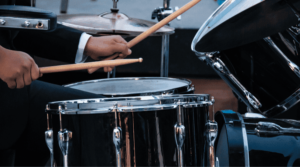Learning to read drum sheet music like a pro opens a new world of musical opportunities, allowing you to understand and perform complex rhythms and pieces with confidence. Whether you’re a beginner or an experienced drummer looking to sharpen your reading skills, mastering the nuances of drum notation can significantly enhance your musicality and versatility. This article delves into the fundamentals of drum sheet music notation, offers tips for efficient sight-reading, explains common symbols and terms, and provides practice strategies to improve your reading skills. Additionally, we’ll explore how to utilize drum sheet music effectively in rehearsals and performances. With dedicated practice and a deep understanding of these concepts, you’ll be on your way to reading drum sheet music like a pro.
Transform your drumming with Drumap, the Grammy Academy awarded app. Dive into 150,000+ drum samples, craft and share beats seamlessly, and gain insights from master drummers. Download now and join our drum community!
1. The Fundamentals of Drum Sheet Music Notation
Drum sheet music is a visual representation of the drums and cymbals in a drum kit, mapped out across a standard musical staff. This system allows drummers to read and perform music accurately. Here’s a breakdown of the main components you’ll encounter:
Principal Notes and Corresponding Drum Kit Components:
- Quarter Notes and Eighth Notes: These are the backbone of most drum rhythms, representing the basic beat or pulse. In drum notation, these notes indicate when to strike the drum or cymbal.
- Kick Drum (Bass Drum): Often represented by a note placed on the bottom space of the staff, indicating when to use the bass drum pedal.
- Snare Drum: Typically shown by a note on the third space from the top of the staff. The snare drum is central to the drum kit’s backbeat.
- Hi-Hat (Closed): Denoted by an “x” note on the top space of the staff, these notes indicate when to strike the closed hi-hat with a stick.
- Hi-Hat (Open): Similar to closed hi-hat notation but often accompanied by a small circle above the note, signaling the drummer to play the hi-hat in its open position.
- Ride Cymbal: Shown by an “x” note on the space just above the top line of the staff, guiding the drummer to play the ride cymbal.
- Crash Cymbal: Indicated by an “x” note on the space above the staff, this note tells the drummer to strike the crash cymbal.
- Toms: Toms are notated on the spaces and lines of the staff, with high tom on the highest line, mid-tom in the middle, and floor tom on the lower spaces or lines. The exact positioning can vary slightly depending on the specific notation style.
Just as important as the notes, rests indicate moments of silence. Rests are critical for timing and rhythm and come in various forms, such as quarter rests or eighth rests, corresponding to their note equivalents in duration.
Sometimes, drum notation will include sticking patterns (R for right hand, L for left hand), helping drummers execute complex rhythms efficiently.
This foundational knowledge, combined with images of notes and sheet music examples we’ll add later, will help you visualize and understand how drum parts are represented in written form. Remember, practice and familiarity with these symbols are key to reading drum sheet music like a pro.
Elevate Your Drumming Skills with Drumap Ready to transform how you write, share, and explore drum notes? Download Drumap, the Grammy Academy awarded music app, and join a vibrant community of drummers and percussionists. With Drumap, you have access to:
🎶 Over 150,000 drum samples and percussive rhythms.
📝 Tools to create and share your drum beats effortlessly.
💡 Inspiration and tips from master drummers across all genres.
2. Tips for Quick and Efficient Sight-Reading
Sight-reading, or reading and performing music at first glance, is a valuable skill for drummers. To enhance your sight-reading abilities, start by familiarizing yourself with common rhythmic patterns and practice reading them in different contexts. Focus on keeping a steady tempo, even if it means slowing down. Use a metronome to help maintain a consistent pace. Additionally, try to look ahead in the music as you play, anticipating the next measures rather than focusing solely on the current beat. This forward-looking approach gives you more time to prepare for complex rhythms or changes.
3. Common Symbols and Terms in Drum Sheet Music Explained
In drum sheet music, dynamics play a crucial role in expressing the musicality and emotional depth of a piece. They instruct drummers on the intensity or volume at which to play, adding nuance and variation to performances. Here’s a deeper exploration of dynamic markings commonly found in drum notation and how they impact drumming:
Dynamic Markings:
- pp (Pianissimo): Very soft. Drummers should play with minimal force, producing a light sound. This dynamic can be particularly effective in quiet, intimate sections of music.
- p (Piano): Soft. Requires a gentle touch, suitable for subdued or delicate passages. In drumming, this might mean using brushes or playing with a lighter stick technique.
- mp (Mezzo Piano): Moderately soft. This dynamic strikes a balance, offering a more nuanced approach than piano. It’s ideal for providing support without overpowering other instruments.
- mf (Mezzo Forte): Moderately loud. A versatile dynamic that’s neither too soft nor too loud, perfect for driving the rhythm without dominating.
- f (Forte): Loud. Drummers should strike with more force, ensuring the beat is prominent and energetic. Forte playing is often used in choruses or climactic sections.
- ff (Fortissimo): Very loud. This dynamic demands powerful playing, making the drums stand out prominently. It’s used in the most intense parts of a piece to create impact.
Additional Dynamics and Techniques:
- Crescendo (Cresc.): Gradually getting louder. Drummers can achieve this by increasing the force of their strokes or by transitioning from lighter to heavier drums/cymbals.
- Decrescendo (Decresc.) or Diminuendo: Gradually getting softer. This involves a gradual reduction in playing intensity, often used to lead into softer sections of a piece.
- Accents: An accent above a note indicates it should be played louder than the surrounding notes. Accents can dramatically shape the feel of a rhythm, adding emphasis and variation.
Understanding and applying dynamic markings are vital for drummers. Dynamics influence the energy and flow of a piece, and being responsive to these markings ensures that the drumming complements the overall musical expression. Drummers must develop the skill to adjust their playing intensity swiftly and smoothly, transitioning between dynamics as the music dictates.
To practice dynamics, drummers can work on exercises that focus on changing volumes, such as playing scales or rudiments with crescendos and decrescendos. Recording practice sessions can also be helpful, as it allows drummers to hear whether they are accurately capturing the intended dynamics.
4. Utilizing Drum Sheet Music in Rehearsals and Performances
In both rehearsals and performances, being able to read drum sheet music allows for quick learning and adaptation to new pieces. During rehearsals, use sheet music to mark down director’s notes, tempo changes, or specific cues that will help you navigate the piece more effectively in performance. Having a solid grasp of drum notation also enables you to communicate more efficiently with bandmates, as you can reference specific measures or beats in the music.
In performances, your sight-reading skills can be a lifeline for navigating unexpected changes or following along with live arrangements. Being adept at reading drum sheet music means you’re always prepared, whether you’re playing a familiar setlist or stepping in with a new group at the last minute.
With Drumap app you get:
- Extensive Groove library with over 150,000 rhythms
- Creating and sharing your drum notes has never been easier! At Drumap, we’ve developed an incredibly user-friendly music creation tool
- Wide array of instruments, from Drum set, Cajon, Rumba or Samba instruments, Congas, you name it, we are all about percussion

5. Practice Strategies for Improving Reading Skills
Improving your drum sheet music reading skills requires consistent practice. Begin with simple rhythms and gradually introduce more complexity as you become comfortable. Splitting your practice sessions into focused segments can be effective—spend time working on rhythm accuracy, dynamic variation, and tempo changes separately before combining them. Recording your practice sessions and listening back can help identify areas for improvement. Additionally, practicing with different genres of music can expose you to a variety of notation styles and rhythmic patterns, broadening your reading skills.
In conclusion, mastering how to read drum sheet music is an invaluable skill that enhances your versatility and confidence as a drummer. By understanding the fundamentals of drum notation, practicing efficient sight-reading techniques, familiarizing yourself with common symbols and terms, and employing strategic practice methods, you’ll be well-equipped to tackle any piece of music. Remember, the key to becoming proficient at reading drum sheet music is patience and consistent practice. With dedication, you’ll find yourself reading and performing with the ease and expertise of a professional drummer. Stay tuned for images of notes and examples of sheet music that will further illustrate these concepts and help solidify your understanding.
Elevate Your Beats with Drumap! Join the Grammy Academy awarded app. Explore 150,000+ drum samples, effortlessly share your creations, and learn from the masters. Download now!
Get ready to take your drumming to the next level. Get expert tips on coordination, drumming techniques, improvisation and more in the post titled “Charting Your Drumming Journey”. / Written by: Raul Rodrigues: CEO of Drumap, Drummer, Music School Director and Mariano Steimberg: Drum Professor at Berklee College of Music, Valencia Campus.










